Middle Blocker in Volleyball: A Definite Guide
learn, play, dominate:
your volleyball journey starts here.
- Understanding the Role of a Middle Blocker
- What is a Middle Blocker?
- Responsibilities of a Middle Blocker
- Mastering Blocking Fundamentals
- Using the Block as an Offensive Weapon
- Essential Skills Beyond the Net
- Expanding Your Role
- Communication is Key
- Physical Development for Middle Blockers
- Mindset of a Middle Blocker
- Advanced Concepts and Strategies
- Learning from the Best
- Your Path to Dominating the Net
Understanding the Role of a Middle Blocker
Middle blockers are the backbone of a volleyball team’s defense and the force behind its quick-tempo offense. These athletes hold a crucial position in the center of the front row, and their ability to dominate the net often dictates a team’s success.
They should constantly be assessing the situation, including:
- Knowing their teammates’ strengths and weaknesses in the front row.
- Analyzing the opposing setter’s tendencies and anticipating potential attacks.
- Recognizing attack strategies to give their own team the best possible advantage.
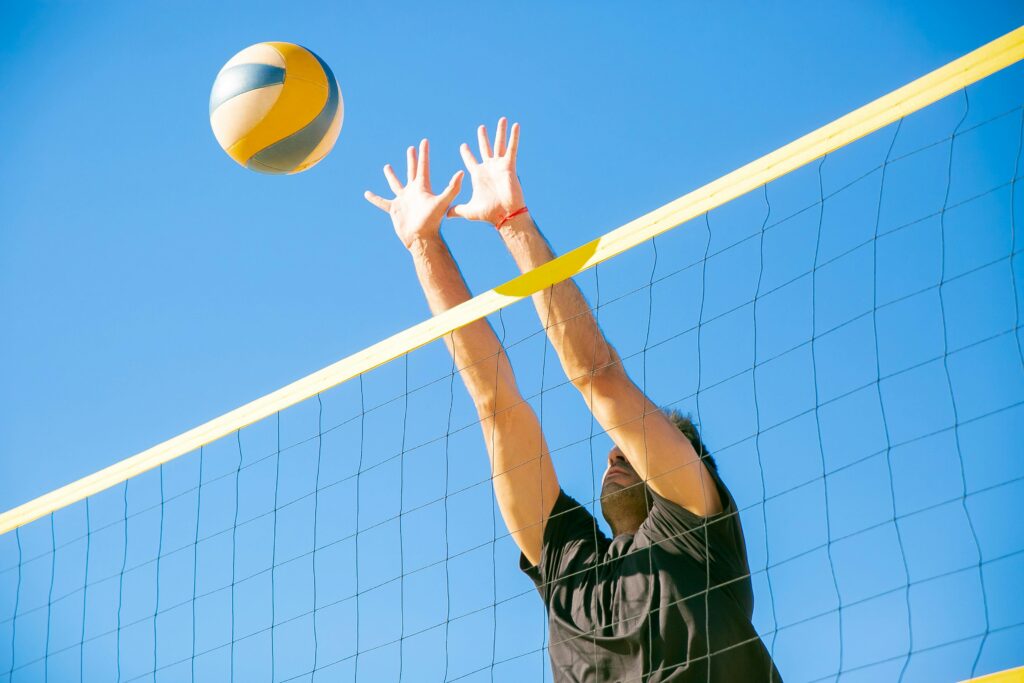
What is a Middle Blocker?
Primary net defender
Middle blockers are the first line of defense against the opponent’s attack. Their main task is to anticipate the opposing attackers’ moves and form a solid wall at the net to block strikes.
Key offensive force in the middle
Middle blockers aren’t just focused on defense. They play a pivotal role in a team’s offensive strategy, executing quick attacks in the middle of the court to keep the opposition on their toes.
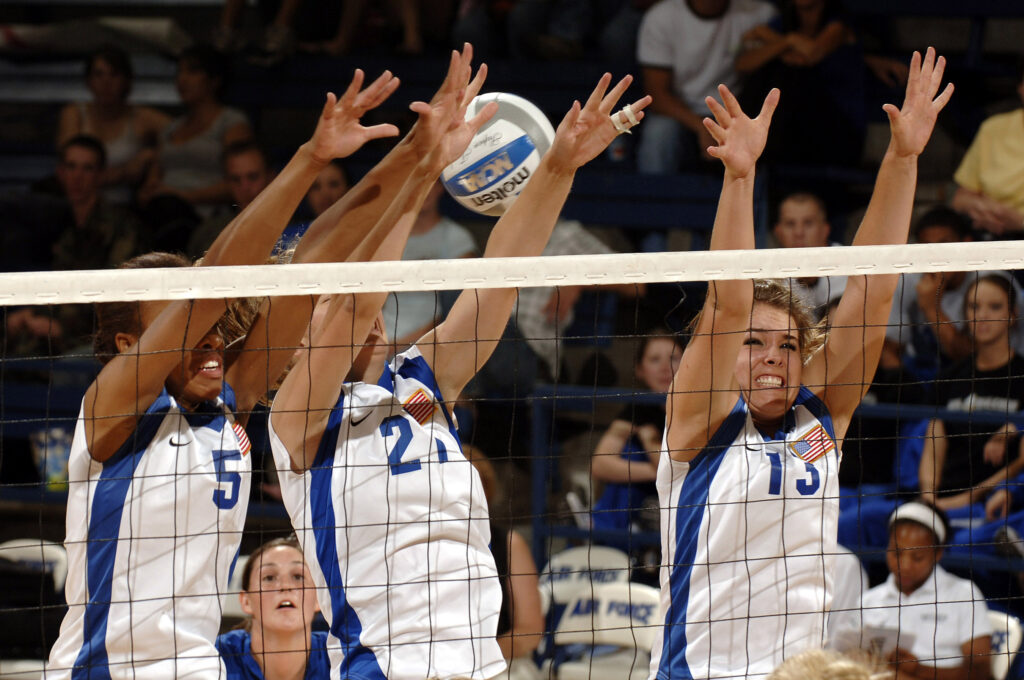
Responsibilities of a Middle Blocker
Blocking opponent’s attacks
Mastering the art of blocking is a middle blocker’s top priority. This means studying opponents’ hitters, using excellent timing, and strong technique to shut down their offensive efforts.
Quick-tempo attacks
Middle blockers must be agile and powerful to run fast-paced plays designed to catch opposing blockers off guard.
Serving effectively
While not a primary focus, a strong and consistent serve from a middle blocker can disrupt the opponent’s rhythm.
Basic back-row defense
Middle blockers are expected to cover their back-row zones, contributing to overall team defense with digs and passes as needed.
Emergency setting if needed
In unusual situations, a middle blocker might be called upon to provide a basic set to a teammate if the team’s primary setter is unable to.
Mastering Blocking Fundamentals
A solid block is a middle blocker’s most powerful tool. Mastering the essential elements of blocking will give you a significant advantage at the net.
Ready Position
- Balanced and Athletic: Start with knees slightly bent, weight evenly distributed, and maintain a slightly forward-leaning posture. This allows you to react quickly in any direction.
- Hands Up and Ready: Hold your hands high in front of you, slightly wider than shoulder-width apart, ready to move swiftly to block.
Reading the Attacker
- Watch the Setter: The setter’s position and body language offer clues as to where the ball is headed.
- Anticipate the Hitter: Observe the hitter’s approach patterns, arm swing, and body cues to predict their attack choice.
- Be aware of your team: Know your teammates’ blocking tendencies and be prepared to adjust to compensate for any weaknesses on the front line.
Blocking and Hand Positioning
- Penetration over the net: Reach aggressively over the net as you block, extending as far into the opponent’s court as possible to reduce their hitting angles.
- Strong hands and wrists: Maintain firm hands and wrists to create a rigid surface for the ball to deflect off of. Spread your fingers but keep them close together.
- Techniques: Soft block, stuff block: Learn different blocking techniques to deal with various attacks:
- Soft block: Slow the ball down, allowing teammates to dig it easily.
- Stuff block: Force the ball straight down on the opponent’s side.
- The front zone is the area between the center line and the attack line. The service zone is the area behind each end line. The substitution zone is located behind the attack line, extending to the scorer’s table.
Using the Block as an Offensive Weapon
A well-executed block isn’t just about defense; it can also set up scoring opportunities for your team.
Timing Your Jump
- Force Bad Shots: A timely jump forces the hitter to alter their attack or make an error.
- Funneling Attacks: Angle your block to direct the ball towards your defenders, making it easier for them to recover.
Attacking Footwork
- Quick Transitions: Immediately after blocking, transition smoothly into your attacking footwork. Use a rapid approach to be ready for quick offensive sets.
Middle Attack Options
- Quick Hit (1): A fast, short attack hitting at the peak of the set.
- Slide: A longer, angled attack synchronized with the setter.
Emphasizing the Block-Attack Connection
The best middle blockers understand the synergy between blocking and attacking. Focus on smooth transitions and quick footwork between blocking duties and offensive plays to make yourself a constant threat at the net.
Remember, your main objective at the net is always to disrupt the opposing hitter’s flow and timing, forcing them into error or a less-than-ideal attack. Your first focus should be a good block.
Essential Skills Beyond the Net
While middle blockers are known for their net presence, a well-rounded skill set makes them even more valuable. Developing these additional skills will significantly boost your effectiveness.
The Importance of Serving
- Powerful jump serves: A forceful jump serve can disrupt the opponent’s reception, immediately putting them on the defensive and giving your team an advantage.
- Controlled float serves: A well-placed float serve with unpredictable movement makes it difficult for the opposition to set up their offense.
Back-Row Defense
- Basic digging and passing skills: Even if you’re rotated to the back row, middle blockers shouldn’t neglect their defense. Practice fundamental digging techniques and passing to contribute to the team’s overall defensive effort.
Emergency Setting
- Situational Awareness: Be aware of when your setter may be in trouble. In scramble situations, a middle blocker might need to step in and provide a basic set to a hitter, keeping the play alive.
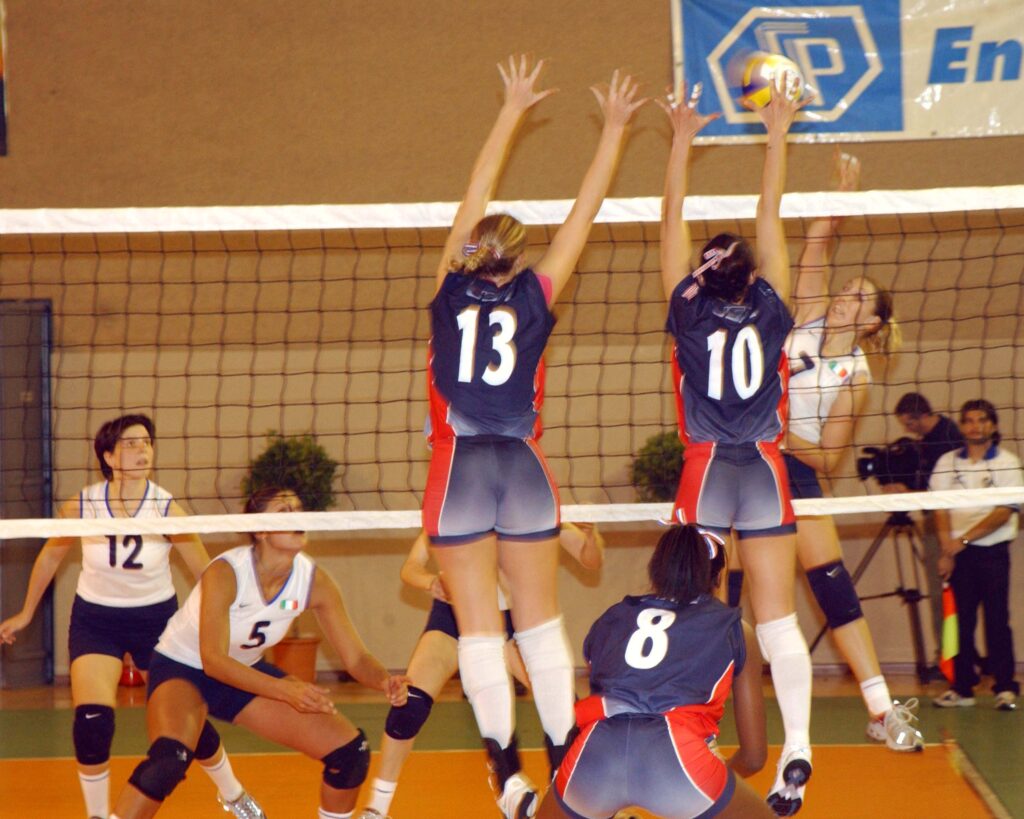
Expanding Your Role
While middle blockers excel at the net, becoming a well-rounded player takes your value to an even higher level. Once you’ve mastered blocking basics, expand your focus to:
- Attacking with Tempo: Learn to hit at various speeds and change up your attack patterns to keep the opponent’s blockers guessing.
- Emergency Situations: Practice basic setting skills so you can assist in a scramble if needed.
- Defensive Awareness: Don’t neglect digging and passing even if you’re an offensive force. Being effective defensively makes you an even greater asset.

Communication is Key
Effective communication is crucial for any volleyball player, but middle blockers have a unique responsibility to orchestrate the net defense.
Working with Your Defense
- Calling the Block: Clearly communicate to your teammates what areas of the court you intend to block and where they should position themselves for optimal coverage.
- Feedback Loop: Talk to your back-row defenders about what you’re seeing from the attackers, and receive their input about hitter tendencies and open spots on the court.
Blocking and Hand Positioning
- Double Blocks: Work with the other blockers to form a strong double block. Decide who takes the lead on each play and communicate who will handle different areas of the net.
- Seam Coverage: Pay close attention to the space between blockers (the seam). Coordinate with your fellow blockers to eliminate gaps for attackers to exploit.
Physical Development for Middle Blockers
Middle blockers rely on a combination of strength, power, and agility to dominate the net. Focused training will enhance your performance.
Strength and Power Training
- Focus on Explosive Movements: Exercises like squats, deadlifts, cleans, and snatches build the strength base for powerful blocking and attacking.
- Core Strength: Develop a strong core through exercises like planks, leg raises, and Russian twists to improve stability and force transfer.
Improving Your Vertical Jump
- Plyometrics: Box jumps, depth jumps, and other plyometric exercises increase your jumping power.
- Resistance Training: Incorporate weighted squats and other exercises to build leg strength.
Agility and Quickness
- Footwork Drills: Ladder drills, cone drills, and lateral movement exercises enhance your ability to react quickly at the net.
- Speed Training: Short sprints and acceleration drills improve your first-step explosiveness for closing the block.
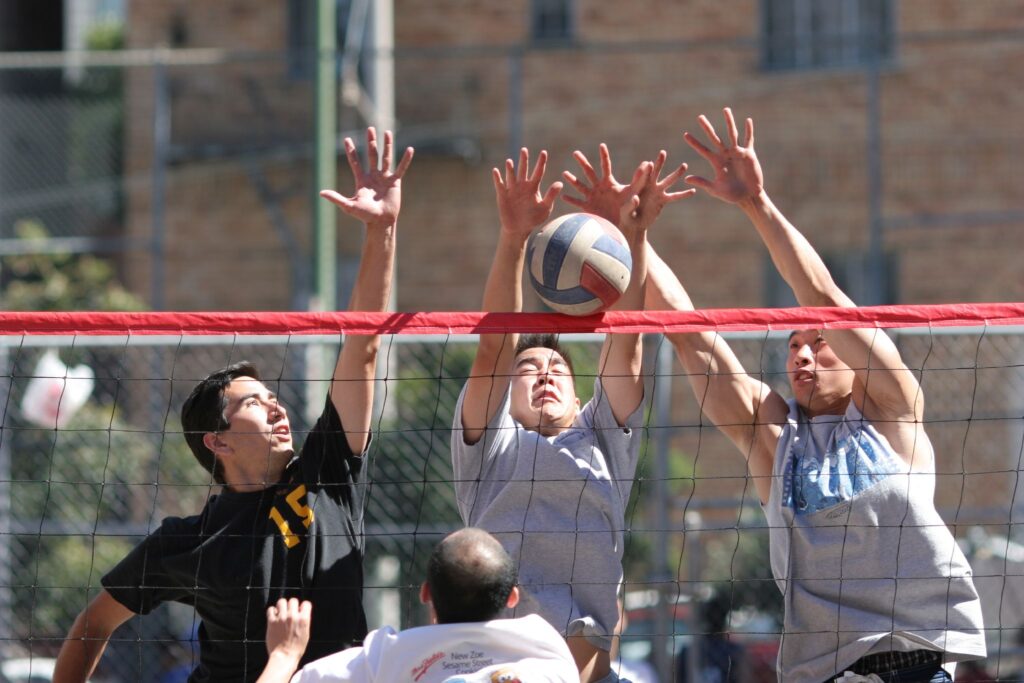
Mindset of a Middle Blocker
Mental toughness is just as important as physical skills for a top-tier middle blocker.
Confidence and Aggression
- Own the Net: Approach your role as the net defender with unwavering confidence and a controlled aggression.
- Intimidating Presence: Make your presence known, challenging attackers and dictating their play choices.
Adaptability
- Reading the Game: Develop the ability to analyze opposing teams’ offensive patterns and adapt your blocking strategies accordingly.
- Adjusting to Different Setters: Be ready to adjust your timing and approach depending on the setter and the tempo of sets.
Mental Preparation
- Visualization for Success: Picture yourself executing perfect blocks and dominating attacks.
- Building a Resilient Mindset: Embrace the challenge of facing powerful hitters and learn to thrive under pressure.
- Maintaining Composure: Develop techniques to stay calm and composed during tense moments of the match.
Advanced Concepts and Strategies
Take your blocking game to the next level by mastering these strategies:
Reading the Set
- Setter’s Body Language: Observe the setter’s hands, shoulders, and even their feet to gather cues about where they intend to set the ball.
- Peripheral Vision: While focusing on the hitter, use your peripheral vision to monitor the set’s trajectory. This allows you to adjust your positioning.
Deception on the Block
- Delayed Jumps: Feign a block early, then jump at the last second to throw off the hitter’s timing.
- Hesitations: Mix in brief hesitations to keep the attacker guessing.
Commit Blocks vs. Read Blocks
- Commit Block: Decisively moving to block a specific area based on your pre-match analysis of the opponent. Used against predictable hitters or when the set is far off the net.
- Read Block: Staying stationary slightly longer, watching the hitter, and reacting to their attack. Ideal when the hitter has several options or the set is closer to the net.
Blocking Against Off-Speed Shots
- Stay Disciplined: Don’t be fooled by slower sets or tips. Maintain proper blocking form and jump timing, adjusting your penetration slightly.
Learning from the Best
Observing elite middle blockers is a fantastic way to elevate your own game.
Great Middle Blockers to Watch
- Maxwell Holt (USA): Master of timing and blocking angles. [Video Link]
- Agustin Loser (Argentina): Imposing presence and aggressive blocking style. [Video Link]
- Marko Podraščanin (Serbia): Veteran with excellent blocking technique.
- Robertlandy Simón (Cuba): Veteran with excellent blocking technique.
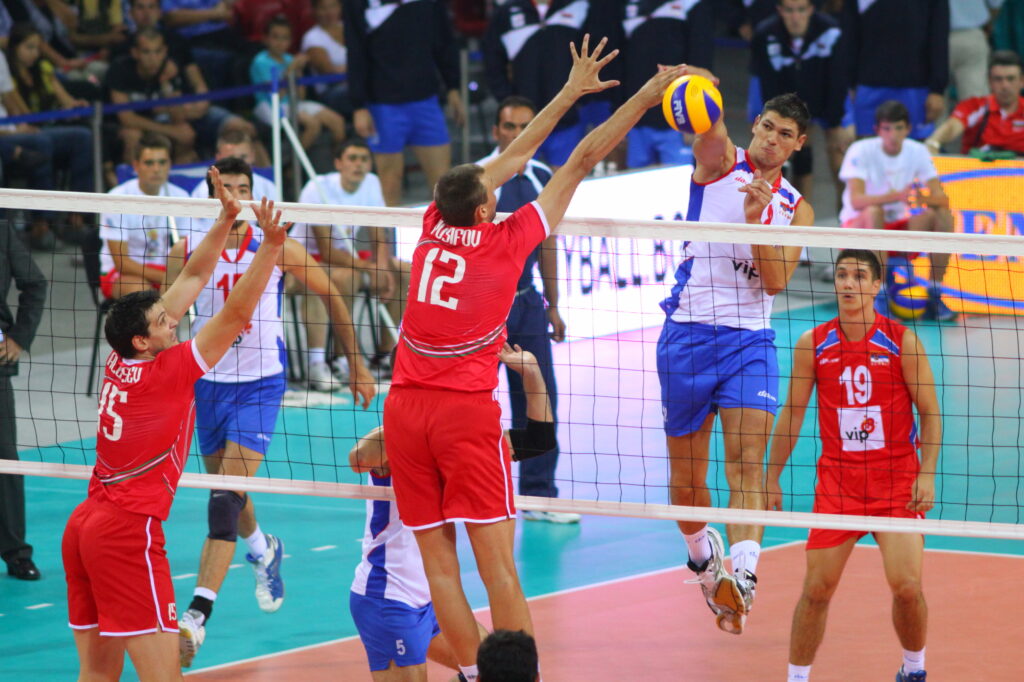
Your Path to Dominating the Net
The journey to becoming an elite middle blocker is a continuous path of learning, refinement, and dedication. The position demands athleticism, intelligence, and a relentless competitive spirit. If you possess these qualities, commit yourself to the principles in this guide. Put in the hard work, focus on constant improvement, and you’ll elevate your game to become the heart of your team’s defense and a driving force behind its offense. Your blocks and attacks will inspire your teammates, intimidate your opponents, and pave the way to victory.